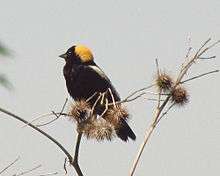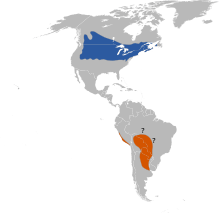Bobolink
| Bobolink | |
|---|---|
 | |
| Scientific classification | |
| Kingdom: | Animalia |
| Phylum: | Chordata |
| Class: | Aves |
| Order: | Passeriformes |
| Family: | Icteridae |
| Genus: | Dolichonyx Swainson, 1827 |
| Species: | D. oryzivorus |
| Binomial name | |
| Dolichonyx oryzivorus (Linnaeus, 1758) | |
 | |
| Approximate distribution. Breeding range Non-breeding range | |
The bobolink (Dolichonyx oryzivorus) is a small New World blackbird and the only member of the genus Dolichonyx.
Etymology
The genus name Dolichonyx is from Ancient Greek dolikhos, "long", and onux, "claw". The specific oryzivorus is from Latin oryza, "rice", and vorare, "to devour"; an old name for this species is "Rice Bird".[2] The English "Bobolink" is from Bob o' Lincoln, describing the call.[3]
Description
Adults are 16–18 cm (6.3–7.1 in) long with short finch-like bills. They weigh about 1 oz (28 g).[4] Adult males are mostly black with creamy napes and white scapulars, lower backs, and rumps. Adult females are mostly light brown, although their coloring includes black streaks on the back and flanks, and dark stripes on the head; their wings and tails are darker. The collective name for a group of bobolinks is a chain.[5]
.jpg)
Distribution and movements
The bobolink breeds in the summer in North America across much of southern Canada and the northern United States.[6] It migrates long distances, wintering in southern South America[6] in Argentina, Bolivia, Brazil and Paraguay. One bird was tracked migrating 12,000 mi (19,000 km) over the course of the year, often flying long distances up to 1,100 mi (1,800 km) in a single day, then stopping to recuperate for days or weeks.[7]
They often migrate in flocks, feeding on cultivated grains and rice, which leads to them being considered a pest by farmers in some areas. Although bobolinks migrate long distances, they have rarely been sighted in Europe—like many vagrants from the Americas, the overwhelming majority of records are from the British Isles.
The species has been known in the southern United States as the "reedbird," or the "ricebird" from their consumption of large amounts of the grain from rice fields in South Carolina and the Gulf States during their southward migration in the fall.[8][9][10] One of the species' main migration routes is through Jamaica, where they're called "butter-birds" and at least historically were collected as food, having fattened up on the aforementioned rice.[9][10]
Behaviour
Breeding
Their breeding habitats are open grassy fields, especially hay fields, across North America. In high-quality habitats, males are often polygynous. Females lay five to six eggs in a cup-shaped nest, which is always situated on the ground and is usually well-hidden in dense vegetation. Both parents feed the young.
Feeding
Bobolinks forage on or near the ground, and mainly eat seeds and insects.
Calls
Males sing bright, bubbly songs in flight.
Status and conservation
The numbers of these birds are declining due to loss of habitat. Bobolinks are a species at risk in Nova Scotia,[11] and throughout Canada.[12] In Vermont, a 75% decline was noted between 1966 and 2007.[4] Originally, they were found in tall grass prairie and other open areas with dense grass. Although hay fields are suitable nesting habitat, fields which are harvested early, or at multiple times, in a season may not allow sufficient time for young birds to fledge. Delaying hay harvests by just 1.5 weeks can improve bobolink survival by 20% [11] This species increased in numbers when horses were the primary mode of transportation, requiring larger supplies of hay.
Media references
Emily Dickinson penned many poems about the bird. Edgar Allan Poe mentions the bird in "Landor's Cottage".
The bobolink is mentioned in the song Evelina by Harold Arlen and Yip Harburg, from the musical Bloomer Girl:[13]
Evelina, won't ya ever take a shine to that moon?
Evelina, ain't ya bothered by the Bobolink's tune?
The bird is also one of the many important ornithological references in Vladimir Nabokov's John Shade's poem "Pale Fire" in the novel of the same name.
Sophia Jewett ends her poem "An Exile's Garden" (1910) with a reference to a bobolink.[14]
The bobolink is also mentioned in the film The Mouse on the Moon in connection with the fictional European microstate of Grand Fenwick, where oddly the bird is apparently common.
The bobolink is also mentioned in the musical Camelot. Words by Alan Jay Lerner.
Gallery
-
_02.jpg)
Male, New England, United States
-
_01.jpg)
Female, New England, United States
References
- ↑ BirdLife International (2012). "Dolichonyx oryzivorus". IUCN Red List of Threatened Species. Version 2013.2. International Union for Conservation of Nature. Retrieved 26 November 2013.
- ↑ Jobling, James A. (2010). The Helm Dictionary of Scientific Bird Names. London, United Kingdom: Christopher Helm. pp. 138, 285. ISBN 978-1-4081-2501-4.
- ↑ "Bobolink". Oxford English Dictionary (3rd ed.). Oxford University Press. September 2005. (Subscription or UK public library membership required.)
- 1 2 Page, Candace (25 June 2010). "1,100 miles in a day". Burlington, Vermont: Burlington Free Press. pp. 1A.
- ↑ "Collective nouns, groups of animals, terms for animal and other groups including birds". Hintsandthings.co.uk. 1980-04-28. Retrieved 2013-05-26.
- 1 2 "Bobolink – Dolichonyx oryzivorus – Overview". Encyclopedia of Life. Retrieved 14 December 2013.
- ↑ Page, Candace (1 April 2011). "Vermont scientists paint detailed picture of bobolink migration". Burlington Free Press. Gannett. Retrieved 14 December 2013.
- ↑ New Jersey. Board of Agriculture (1892). State of New Jersey: Nineteenth Annual Report of the State Board of Agriculture, 1891–92. Trenton, NJ: New Jersey State Board of Agriculture. p. 156. Retrieved 14 December 2013.
- 1 2 Chapman, Frank M., ed. (1909). Bird-lore: An Illustrated Bi-monthly Magazine Devoted to the Study and Protection of Birds. 11. Wright, Mabel Osgood; Dutcher, William. The Macmillan Company. pp. 372–376. Retrieved 14 December 2013.
- 1 2 "Common Names for Bobolink (Dolchonyx oryzivorus)". Encyclopedia of Life. Retrieved 14 December 2013.
- 1 2 "bw_logo - Nova Scotia Federation of Agriculture".
- ↑ http://www.sararegistry.gc.ca/species/speciesDetails_e.cfm?sid=1087
- ↑ Who Put the Rainbow in the " Wizard of Oz? ": Yip Harburg, Lyricist - Harold Meyerson, Ernest Harburg - Google Books. Books.google.com. Retrieved 2013-05-26.
- ↑ The poems of Sophie Jewett - Sophie Jewett - Google Boeken. Books.google.com. Retrieved 2013-05-26.
External links
| Wikimedia Commons has media related to Bobolink. |
| Wikispecies has information related to: Dolichonyx oryzivorus |
- Smithsonian Migratory Bird Center: Bobolink
- Bobolink – Cornell Lab of Ornithology
- The Nature Conservancy's Grassland Birds: Bobolink
- Bobolink - Dolichonyx oryzivorus - USGS Patuxent Bird Identification InfoCenter
- "Bobolink media". Internet Bird Collection.
- Bobolink photo gallery at VIREO (Drexel University)
